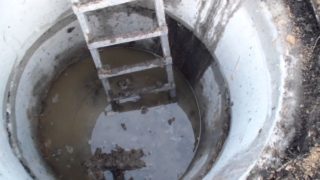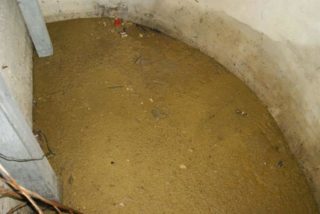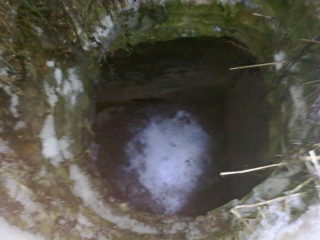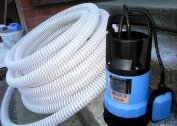A large proportion of private houses in Russia do not have access to centralized sewage networks. To drain domestic wastewater in such houses, an autonomous system is established, which, as a rule, consists of a simple cesspool. If the sewage well is properly equipped, then at first it performs its function perfectly. But in the process of prolonged use or because of an increase in the number of people living in the house, a problem often arises with accelerated filling of the tank, which causes a lot of trouble to the owners. The following are the most common causes of this situation and how to fix the problem.
Reasons for fast filling
 Common causes of premature cesspool overflow:
Common causes of premature cesspool overflow:
- Siltation - the bottom and walls of the cesspool are covered with deposits that block the effective absorption of water into the soil;
- Fat - discharge into the sewage system of fat from the kitchen leads to the formation of an insoluble film and prevents water from leaving;
- Water freezing - A common problem in regions with harsh winters. There is no power to pass drains.
- Volume mismatch for needs - septic tank throughput is less than the actual volume of effluents leaving the house.
It is worth considering each of the problems described in more detail in order to understand the cause of the trouble and choose an effective way out of this situation.
Bottom siltation
 A decrease in the useful volume of the waste tank is one of the most characteristic signs of siltation of the bottom and walls of a well pit, in which there is no bottom. One of the reasons for the appearance of sludge may be getting into the drains of food residues from the kitchen, toilet paper, etc. Such items decompose for a long time, turning as they break down into a viscous mass with an unpleasant odor.
A decrease in the useful volume of the waste tank is one of the most characteristic signs of siltation of the bottom and walls of a well pit, in which there is no bottom. One of the reasons for the appearance of sludge may be getting into the drains of food residues from the kitchen, toilet paper, etc. Such items decompose for a long time, turning as they break down into a viscous mass with an unpleasant odor.
Other typical indicators of sludge accumulation are:
- the appearance of an unpleasant odor from the cesspool;
- silt can be seen with the naked eye when examining a septic tank.
The presence of the above problems indicates that autonomous sewage needs thorough cleaning work. There are many ways to deal with silt deposits:
- Manual cleaning. Existing fluid is pumped out by a drainage pump or scooped out in buckets. The use of a fecal pump with the function of grinding dense masses can significantly simplify the task. The mass of sludge is removed from the bottom manually, if its density is high, you can use metal brushes. The method is very economical in terms of costs, but rather complicated and time-consuming.
- Pumping sewage using a sewage machine. The call of specialized equipment will greatly facilitate cleaning. It is recommended to perform double pumping - for the first time, drains accumulated in the pit are removed. Sludge masses are poured with clean water, softened and must also be removed. The method is quite working, but a regular call to the scavengers will cost you a lot of money.
- Dry cleaning. Effectively fights hard deposits. It is important to remember that leaving the “chemistry” in the pit is unsafe for the environment. Substances can get into the soil, causing subsequent problems with the cultivation of garden crops on the house plot; or reach sources of water, then it will become unsuitable for drinking and watering. Therefore, chemically treated effluents are subject to pumping, after which the septic tank will again be safe and will perform its functions more intensively.
- The use of biologically active substances for decomposition of sludge masses.Both liquid and powder forms are on sale, which need to be dissolved in water and introduced into the sewage pit. Bacteria and microorganisms contained in such products are able to soften the crust of sludge, reduce its amount and, with regular use, remove unpleasant odors. There is an important caveat - microorganisms are effective only at temperatures above +5 degrees, which means that you will have to use other methods to clean the sludge in the cold season. Another feature - bacteria colonies work only when a certain concentration is reached. It is necessary to periodically add biological products to the stock.
Body fat
 Fat deposits can enter the sewer system of a private house, mainly from the kitchen. The fat that we wash off the dishes detergents do not completely decompose. First, it enters the pipes, and then into the cesspool, creating a thin film on the surface of the bottom and walls, which prevents the normal outflow of liquid into the soil.
Fat deposits can enter the sewer system of a private house, mainly from the kitchen. The fat that we wash off the dishes detergents do not completely decompose. First, it enters the pipes, and then into the cesspool, creating a thin film on the surface of the bottom and walls, which prevents the normal outflow of liquid into the soil.
All the same biological products with living bacteria will help to cope with such a problem, they decompose fat deposits well and prevent the formation of new ones.
The use of caustic soda is no less effective, but it must be borne in mind that if the volume of the sewage pit is large, then a chemical agent will also be needed. Moreover, its use is unsafe for humans and the environment, it is necessary to work with the product with extreme caution, since it is a strong alkali. To work with the substance rubber gloves are required, as well as a respirator and glasses. Caustic is loose, but it is added directly to the septic tank only after preliminary dissolution in water. It acts quickly, literally within 5 minutes. Then the resulting mass must be pumped out, after which a double washing of the pit with clean water is necessary.
A very effective preventive measure is to install a grease trap in the kitchen. The smart appliance is mounted under the sink and prevents grease from entering the wastewater.
Wastewater freezing
 In regions with severe winters, the cause of a decrease in the capacity of a cesspool is often its freezing. Ice crust significantly slows the outflow of fluid. In this case, there is only one way out - to defrost the waste tank. There are several ways to do this:
In regions with severe winters, the cause of a decrease in the capacity of a cesspool is often its freezing. Ice crust significantly slows the outflow of fluid. In this case, there is only one way out - to defrost the waste tank. There are several ways to do this:
- using a soldering iron;
- using a heat gun or industrial hair dryer;
- using special means for melting ice - special liquids and powders melt the ice and prevent its subsequent formation.
It is believed that if the pit was originally correctly built (the depth of soil freezing has been taken into account and there is sufficient volume), it will not freeze completely, an ice crust forms only on the surface. You can resort to additional insulation of the pit, this will help to avoid further problems with its freezing.
Discrepancy in drain pit volume
 It happens that the overflow of the drain pit is caused by an excess of effluents entering it. This can happen due to design errors or an increase in the number of people who use sewers. As a rule, 0.5-0.8 cubic meters are laid per person. The volume of the cesspool should not be less than the average daily volume of wastewater flowing into it. If this parameter is exceeded, more frequent emptying of the tank or its expansion will be required. It is convenient to proceed as follows:
It happens that the overflow of the drain pit is caused by an excess of effluents entering it. This can happen due to design errors or an increase in the number of people who use sewers. As a rule, 0.5-0.8 cubic meters are laid per person. The volume of the cesspool should not be less than the average daily volume of wastewater flowing into it. If this parameter is exceeded, more frequent emptying of the tank or its expansion will be required. It is convenient to proceed as follows:
- the existing sump is concreted, becoming airtight;
- a second pit is being equipped nearby, which will be connected to the first using an overflow system;
- then primary drains will accumulate in the first “chamber”, from which the liquid fraction will enter the next reservoir.
- clarified effluents thus obtained without solid content will be easily absorbed into the soil.
If free space in the local area allows, many will prefer to dig a new sump than to mess with the old one.Nevertheless, it is better to immediately immediately correctly arrange a place for domestic wastewater and use it wisely, this will help to avoid problems in the future.


